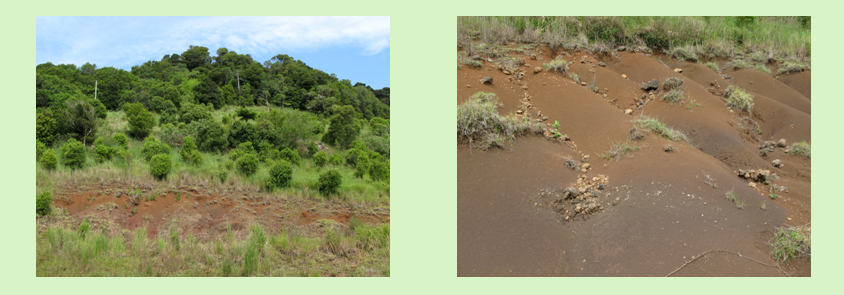 Springbrook Rescue
Springbrook Rescue
 Springbrook Rescue
Springbrook Rescue
| Home | The Vision | Springbrook — A Natural Wonder | The Springbrook Rescue Project | Support the Project | About ARCS |
Menu
Soils Understanding soils is vital to understanding the systems that support life on earth and underpin the extraordinary long-term persistence of some of life’s ancient ancestry. Formed by the weathering of rock and minerals in the earth’s crust over millions of years and the actions of trillions of microorganisms and fungi, soils mediate the fundamental biogeochemical cycles of water, carbon, nitrogen, phosphorus and sulphur that are essential for life. All terrestrial ecosystems are founded on soil. Most plants rely solely on soil for water, their nutrients and anchorage. The Australian continent is renowned for its age, tectonic stability and relative freedom from glaciation that stripped northern hemisphere continents of their life-giving soils some 18,000 years ago. In contrast, Australia’s soils are mostly very old, shallow and extremely weathered leaving them low in nutrients and water holding capacity. Landscapes flattened and vegetation adapted. Deserts and sclerophyllous vegetation flourished whilst, ancient Tertiary rainforests survived only in comparatively small refuges that could buffer them against change. Soils and the ecosystem processes they support are a fundamental part of that buffering. Their origins and properties need to be understood in order to protect and restore the integrity of World Heritage areas such as the Gondwana Rainforests of Australia. Soils on Springbrook plateau, in contrast to most of the rest of the continent are deep and rich in nutrients. At a time when climate and soil fertility in Australia were deteriorating precipitously, volcanism was a restorative force. Soils based on basalts are higher in nutrients than any other soil type, but fertility varies depending on extent of weathering, slope, aspect, drainage and history of clearing and land use. Basalts are rich in readily weathered minerals especially iron, calcium, magnesium and phosphorus. They have high clay content but are substantially lacking in resistant minerals such as quartz. Under strongly leaching conditions of high rainfall, silica and cations are lost leaving behind deep red soils rich in kaolinitic clay and iron oxides. These Red Ferrosols characterise the rainforests of eastern Australia (McKenzie et al. 2004). Their fertility is easily lost by clearing. The forest canopies act as major stores of nutrients buffering losses through soil erosion and leaching. Soil parent material and depth affect nutrient availability, soil water storage potential and rooting depth. Soil type and condition thus determine the species composition of vegetation supported. For example, fleshy fruits are expensive in potassium, thus fleshy-fruited species are unlikely on infertile soils (Westoby et al. 1991). The Springbrook plateau conserves major gradients in soil types differing in soil moisture holding capacity and nutrient content. These range from Black Earths (Vertisols) though Red Kraznozems (Ferrosols), Prairie soils (Dermasols), Yellow Podzolic Soils (Dermosols) to shallow Lithosols (Isbell 2002, Wilmott and Hayne 2001). Rhyolite rocks, being relatively stable and comprising mainly silica, alumina and potassium, weather to shallow, pale-coloured soils of poor fertility. These shallow Lithosols can be less than 20 cm deep and are more likely to support montane heaths and eucalypt vegetation. |
|
 | |
Erosion of basalt soils on Pallida, one of the restoration properties, creeping up the slope. The erosion results from construction of a dam |
|
|
References Isbell, R.F. (2002). The Australian Soil Classification. CSIRO Publishing. Revised Edition, Reprinted 2003. McKenzie, N., Jacquier, D., Isbell, R. and Brown, K. (2004). Australian Soils and Landscapes: An lllustrated Compendium. CSIRO Publishing. Westoby, M., French, K., Hughes, L., Rice, B. and Rodgerson, L. (1991). Why do more plant species use ants for dispersal in infertile compared with fertile soils? Austral Ecology 16(4), 445-455. Willmott, W.F. and Hayne, M. (2001) Slope stability and its constraints on closer settlement, Springbook Plateau and upper Tallebudgera and Currumbin Valleys, south-east Queensland / W.F. Willmott & M Hayne, Dept. of Mines and Energy, Brisbane. | |